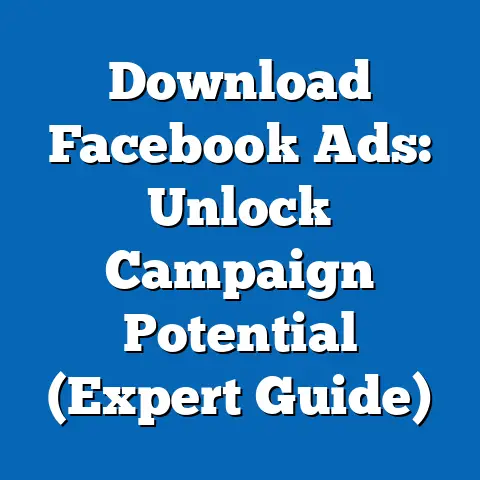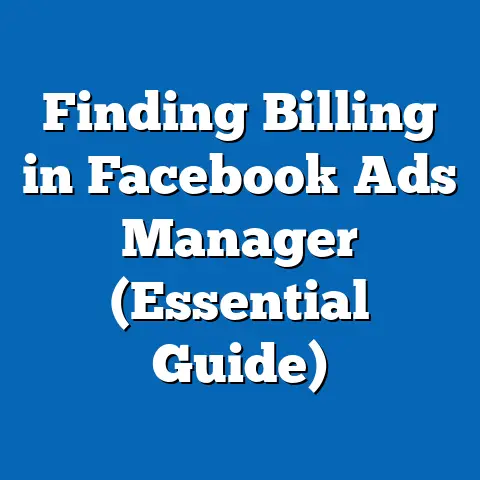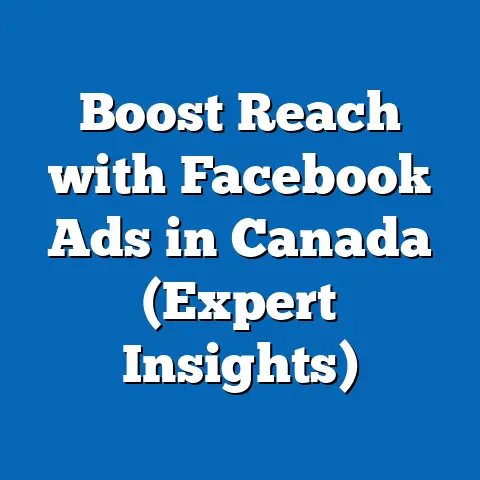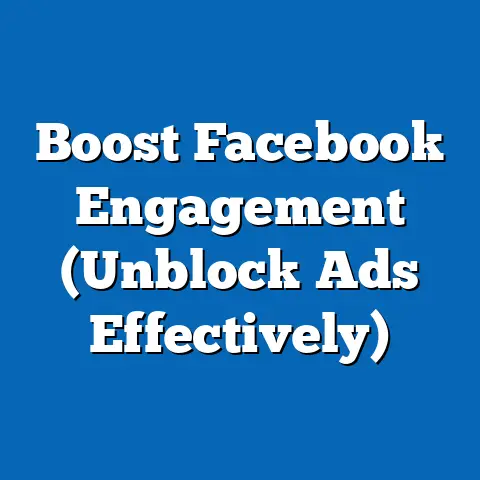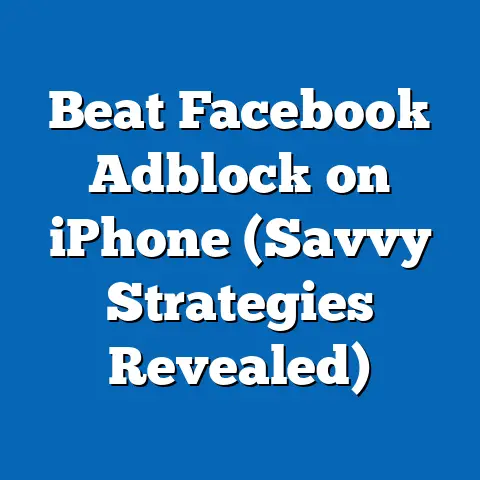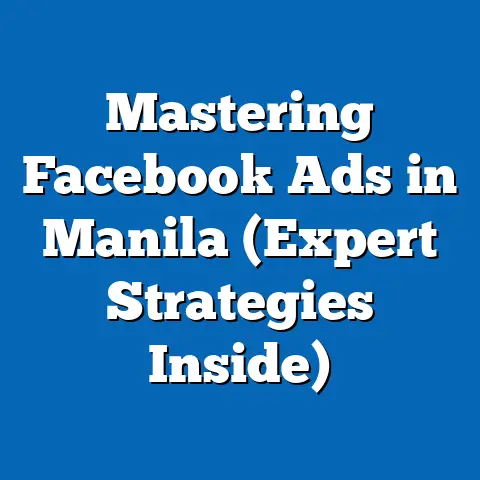Transform Ads for Facebook Success (Expert Strategies)
In the bustling world of Facebook advertising, it’s easy to get lost in the technicalities – the bidding strategies, the pixel tracking, the ever-changing algorithm. But I’ve learned, through years of trial and error (and a few sleepless nights!), that the real magic happens when you connect with the lifestyle needs of your target audience.
Think about it: people aren’t just buying products or services; they’re buying into a lifestyle, an aspiration, a solution to a problem that’s deeply personal. Their preferences, their challenges, their dreams – these are the things that shape their behavior and ultimately, their purchasing decisions.
I remember working with a small, local coffee shop that was struggling to stand out in a crowded market. We started by diving deep into their target audience: young professionals, students, and creatives who valued quality coffee, a cozy atmosphere, and a sense of community. Instead of just pushing generic ads about coffee, we crafted ads that spoke to their lifestyle: “Fuel your late-night study sessions with our ethically sourced beans,” or “Escape the office grind with a perfectly brewed latte in our cozy corner.” The result? A significant increase in foot traffic and a loyal customer base.
Section 1: Understanding Your Audience
Before you even think about crafting an ad, you need to become intimately familiar with your target audience. This goes beyond basic demographics like age and location. We’re talking about understanding their values, their interests, their aspirations, and their pain points.
I’ve seen so many businesses waste money on ads that are simply irrelevant to their target audience. They’re shouting into the void, hoping someone will listen. But the key to successful Facebook advertising is to whisper directly into the ear of your ideal customer.
So, how do you gather these crucial insights? Here are a few methods I’ve found particularly effective:
- Surveys: Don’t underestimate the power of a well-crafted survey. Use tools like SurveyMonkey or Google Forms to ask your existing customers about their lifestyle, their interests, and their challenges. Offer an incentive, like a discount or a free gift, to encourage participation.
- Social Listening: Pay attention to what your target audience is saying online. Monitor relevant hashtags, forums, and social media groups. What are they talking about? What are their concerns? What are their aspirations? Tools like Brandwatch or Mention can help you track these conversations.
- Facebook Insights: This is a goldmine of information right at your fingertips. Facebook Insights provides detailed data about your audience, including their demographics, interests, and behaviors. Analyze this data to identify patterns and trends.
- Customer Interviews: Sometimes, the best way to understand your audience is to simply talk to them. Conduct one-on-one interviews with your existing customers. Ask them about their lives, their challenges, and their reasons for choosing your product or service.
Once you’ve gathered this information, the next step is to create detailed customer personas. A customer persona is a fictional representation of your ideal customer. It should include demographic information, interests, lifestyle habits, and pain points.
For example, let’s say you’re selling yoga apparel. Your customer persona might look something like this:
Name: Sarah Miller
Age: 32
Occupation: Marketing Manager
Location: San Francisco, CA
Interests: Yoga, hiking, healthy eating, mindfulness
Lifestyle: Sarah is a busy professional who values health and wellness. She practices yoga several times a week and enjoys spending time outdoors. She’s always looking for ways to reduce stress and improve her overall well-being.
Pain Points: Sarah struggles to find time for self-care amidst her busy schedule. She’s also looking for high-quality yoga apparel that is both comfortable and stylish.
By creating detailed customer personas like this, you can gain a deeper understanding of your target audience and tailor your ads to their specific needs and interests.
I recall working with a fitness brand that initially struggled with their Facebook ads. They were targeting a broad audience with generic ads about weight loss. But after conducting thorough audience research and creating detailed customer personas, we realized that their target audience was much more specific: busy moms who wanted to get back in shape after having children.
We then crafted ads that spoke directly to these moms, highlighting the convenience and effectiveness of their fitness program. We used images of real moms working out and shared testimonials from other moms who had achieved great results. The result? A significant increase in leads and sales.
Key Takeaway: Understanding your audience is the foundation of successful Facebook advertising. Invest the time and effort to gather insights and create detailed customer personas. This will help you craft ads that are relevant, engaging, and ultimately, more effective.
Section 2: Crafting Compelling Ad Copy
Now that you have a deep understanding of your target audience, it’s time to craft compelling ad copy that speaks directly to their lifestyle needs. This is where the art of persuasive writing comes into play.
Forget about generic sales pitches and boring product descriptions. Instead, focus on creating ad copy that is relatable, engaging, and emotionally resonant.
Here are a few tips to help you craft compelling ad copy:
- Use Relatable Language: Speak to your audience in their own language. Avoid jargon and technical terms. Use words and phrases that they will understand and connect with.
- Tell a Story: People love stories. Use storytelling elements in your ad copy to capture their attention and draw them in. Share a personal anecdote, a customer testimonial, or a fictional scenario that resonates with their lifestyle.
- Focus on Benefits, Not Features: Don’t just list the features of your product or service. Instead, focus on the benefits that it provides. How will it improve their lives? How will it solve their problems?
- Use Emotional Triggers: Tap into the emotions of your target audience. Use words and phrases that evoke feelings of happiness, excitement, fear, or urgency.
- Create a Sense of Urgency: Encourage people to take action now. Use phrases like “Limited Time Offer,” “Don’t Miss Out,” or “Shop Now.”
- Include a Clear Call to Action: Tell people exactly what you want them to do. Use phrases like “Learn More,” “Shop Now,” or “Sign Up Today.”
I always tell my clients to imagine they’re having a conversation with their ideal customer. What would they say to them? How would they convince them to buy their product or service?
Let’s look at a few examples of high-performing ad copies that exemplify these strategies:
Example 1: A Travel Agency Targeting Adventurous Millennials
Headline: Escape the Ordinary: Discover Hidden Gems Off the Beaten Path
Body: Tired of the same old tourist traps? We curate unique travel experiences for adventurous millennials who crave authentic cultural immersion. Imagine yourself hiking through the remote mountains of Nepal, exploring the ancient ruins of Machu Picchu, or diving in the crystal-clear waters of the Maldives. Our expert guides will take you off the beaten path and show you the world like never before.
Call to Action: Book Your Adventure Today!
Why it Works: This ad copy speaks directly to the lifestyle needs of adventurous millennials who are looking for unique and authentic travel experiences. It uses relatable language, tells a story, and focuses on the benefits of the travel agency’s services. It also includes a clear call to action.
Example 2: A Subscription Box for Busy Professionals
Headline: Simplify Your Life with Our Curated Subscription Box
Body: Are you a busy professional who doesn’t have time to shop for groceries, plan meals, or try new products? Our curated subscription box delivers everything you need right to your doorstep. Each month, you’ll receive a selection of healthy snacks, delicious recipes, and innovative lifestyle products designed to simplify your life and help you thrive.
Call to Action: Get Your First Box Today!
Why it Works: This ad copy speaks to the lifestyle needs of busy professionals who are looking for convenience and efficiency. It uses relatable language, tells a story, and focuses on the benefits of the subscription box. It also includes a clear call to action.
Key Takeaway: Crafting compelling ad copy is essential for capturing the attention of your target audience and driving engagement. Use relatable language, tell a story, focus on benefits, and include a clear call to action.
Section 3: Visual Storytelling in Ads
While compelling ad copy is crucial, don’t underestimate the power of visuals. In the fast-paced world of social media, visuals are often the first thing that catches someone’s eye. They can communicate a message quickly and effectively, and they can evoke emotions that words alone cannot.
That’s why visual storytelling is such an important aspect of Facebook advertising. By using high-quality images and videos that reflect the lifestyle and values of your target audience, you can create ads that are both engaging and memorable.
Here are a few tips for using visual storytelling in your ads:
- Use High-Quality Images and Videos: This is a no-brainer, but it’s worth repeating. Use images and videos that are well-lit, in focus, and visually appealing. Avoid using stock photos that look generic and staged.
- Reflect the Lifestyle and Values of Your Target Audience: Choose visuals that resonate with the lifestyle and values of your target audience. If you’re targeting adventurous millennials, use images of people hiking, exploring, or traveling. If you’re targeting busy professionals, use images of people working, collaborating, or relaxing.
- Evoke Emotions: Use visuals that evoke emotions. Images of happy people, beautiful landscapes, or heartwarming scenes can capture the attention of viewers and create a positive association with your brand.
- Maintain Brand Consistency: Ensure that your visuals are consistent with your brand’s overall aesthetic. Use the same colors, fonts, and style in all of your ads.
- Use Video to Tell a Story: Video is a powerful medium for storytelling. Use video to share customer testimonials, showcase your product in action, or create a behind-the-scenes look at your company.
I’ve seen firsthand how effective visual storytelling can be. I worked with a local bakery that was struggling to attract new customers. We started by taking high-quality photos of their delicious pastries and cakes. But instead of just posting static images, we created short videos that showed the bakers in action, kneading dough, decorating cakes, and interacting with customers.
These videos were a huge hit. People loved seeing the passion and craftsmanship that went into each and every pastry. The bakery saw a significant increase in foot traffic and online orders.
Let’s look at a few case studies of successful Facebook ad campaigns that used visual storytelling to captivate viewers and drive engagement:
Case Study 1: Airbnb’s “Live There” Campaign
Airbnb’s “Live There” campaign used stunning visuals to showcase the unique experiences that travelers can have when they stay in Airbnb homes. The campaign featured videos of people exploring local neighborhoods, interacting with residents, and immersing themselves in the local culture. The visuals were authentic, relatable, and emotionally resonant. The campaign was a huge success, driving increased brand awareness and bookings.
Case Study 2: Dove’s “Real Beauty” Campaign
Dove’s “Real Beauty” campaign used visuals to challenge traditional beauty standards and celebrate the diversity of women. The campaign featured images and videos of women of all shapes, sizes, and ethnicities. The visuals were empowering, inspiring, and emotionally resonant. The campaign was a huge success, driving increased brand loyalty and positive brand sentiment.
Key Takeaway: Visual storytelling is a powerful tool for capturing the attention of your target audience and driving engagement. Use high-quality images and videos that reflect the lifestyle and values of your target audience, evoke emotions, and maintain brand consistency.
Section 4: Utilizing Facebook’s Targeting Features
Now that you have compelling ad copy and engaging visuals, it’s time to make sure your ads are reaching the right audience. This is where Facebook’s advanced targeting features come into play.
Facebook offers a wide range of targeting options that allow you to reach users based on their demographics, interests, behaviors, and connections. By leveraging these features effectively, you can ensure that your ads are seen by people who are most likely to be interested in your product or service.
Here are a few of Facebook’s most powerful targeting features:
- Custom Audiences: Custom Audiences allow you to target people who have already interacted with your business. You can create a Custom Audience based on your customer list, website traffic, app activity, or engagement on Facebook.
- Lookalike Audiences: Lookalike Audiences allow you to target people who are similar to your existing customers. You can create a Lookalike Audience based on your customer list, website traffic, app activity, or engagement on Facebook.
- Interest-Based Targeting: Interest-based targeting allows you to target people based on their interests, hobbies, and passions. You can target people who are interested in specific topics, activities, or brands.
- Behavioral Targeting: Behavioral targeting allows you to target people based on their online behavior, such as their purchase history, travel habits, or device usage.
- Demographic Targeting: Demographic targeting allows you to target people based on their age, gender, location, education, and other demographic information.
I’ve found that the key to successful targeting is to combine different targeting options to create a highly specific audience. For example, you could target women aged 25-34 who live in San Francisco, are interested in yoga, and have purchased yoga apparel online in the past.
Let’s look at a few real-world examples of how precise targeting leads to increased ad relevance and improved ROI:
Example 1: A Local Restaurant Targeting Foodies
A local restaurant wanted to attract more customers during lunchtime. They used Facebook’s targeting features to target people who lived within a 5-mile radius of the restaurant, were interested in food and dining, and had checked into other restaurants in the area. They also created a Custom Audience based on their email list and targeted people who had previously dined at the restaurant. The result? A significant increase in lunchtime traffic and a boost in sales.
Example 2: An Online Clothing Retailer Targeting Fashionistas
An online clothing retailer wanted to increase sales of their new summer collection. They used Facebook’s targeting features to target women aged 18-34 who were interested in fashion, shopping, and beauty. They also created a Lookalike Audience based on their existing customer list and targeted people who were similar to their best customers. The result? A significant increase in website traffic, sales, and ROI.
Key Takeaway: Facebook’s advanced targeting features are a powerful tool for reaching the right audience and improving your ad performance. Use a combination of different targeting options to create a highly specific audience that is most likely to be interested in your product or service.
Section 5: Analyzing and Optimizing Ad Performance
You’ve created compelling ads, targeted the right audience, and launched your campaign. But your work isn’t done yet. The final step is to analyze and optimize your ad performance.
Data analysis is crucial for understanding what’s working and what’s not. By tracking key performance metrics and identifying trends, you can make informed decisions about how to improve your ad performance and maximize your ROI.
Here are a few key performance metrics to track:
- Click-Through Rate (CTR): The percentage of people who click on your ad after seeing it. A high CTR indicates that your ad is relevant and engaging.
- Conversion Rate: The percentage of people who take a desired action after clicking on your ad, such as making a purchase, signing up for a newsletter, or filling out a form. A high conversion rate indicates that your ad is effective at driving results.
- Engagement Level: The number of likes, comments, and shares your ad receives. A high engagement level indicates that your ad is resonating with your audience.
- Cost Per Click (CPC): The amount you pay each time someone clicks on your ad. A low CPC indicates that your ad is efficient at driving traffic.
- Cost Per Conversion (CPA): The amount you pay each time someone takes a desired action after clicking on your ad. A low CPA indicates that your ad is cost-effective at driving results.
Facebook Ads Manager provides a wealth of data and insights that you can use to monitor your ad performance. Use this tool to track your key performance metrics, identify trends, and make informed decisions about how to improve your ad performance.
I always recommend A/B testing different ad elements to optimize performance continually. A/B testing involves creating two versions of an ad with slight variations and then comparing their performance to see which one performs better. You can A/B test different headlines, body copy, visuals, call-to-actions, and targeting options.
For example, you could A/B test two different headlines to see which one generates a higher CTR. Or you could A/B test two different visuals to see which one drives more conversions.
By A/B testing different ad elements, you can continually optimize your ad performance and maximize your ROI.
I remember working with a client who was struggling to generate leads for their online course. We started by A/B testing different headlines and found that headlines that focused on the benefits of the course performed much better than headlines that focused on the features. We then A/B tested different visuals and found that visuals that showed real people using the course performed better than visuals that showed stock photos. By continually A/B testing different ad elements, we were able to significantly improve the ad performance and generate a steady stream of leads.
Key Takeaway: Data analysis and optimization are essential for maximizing your ad performance and ROI. Track your key performance metrics, identify trends, and A/B test different ad elements to continually improve your ad performance.
Conclusion
Transforming Facebook ads for success hinges on understanding and addressing the lifestyle needs of your audience. It’s about going beyond generic marketing tactics and diving deep into the hearts and minds of your ideal customers.
I’ve shared expert strategies in this article, and I encourage you to implement them in your own advertising efforts. Remember:
- Understand Your Audience: Invest the time and effort to gather insights and create detailed customer personas.
- Craft Compelling Ad Copy: Use relatable language, tell a story, focus on benefits, and include a clear call to action.
- Use Visual Storytelling: Use high-quality images and videos that reflect the lifestyle and values of your target audience, evoke emotions, and maintain brand consistency.
- Leverage Facebook’s Targeting Features: Use a combination of different targeting options to create a highly specific audience that is most likely to be interested in your product or service.
- Analyze and Optimize Your Ad Performance: Track your key performance metrics, identify trends, and A/B test different ad elements to continually improve your ad performance.
The potential impact of effective Facebook advertising on business growth and customer engagement is immense. By connecting with your audience on a personal level, you can build strong relationships, drive engagement, and ultimately, achieve greater success on the platform. Don’t be afraid to experiment, to test, and to learn. The world of Facebook advertising is constantly evolving, and the key to success is to be adaptable and to always be learning. Now, go out there and transform your Facebook ads into powerful tools for business success!

